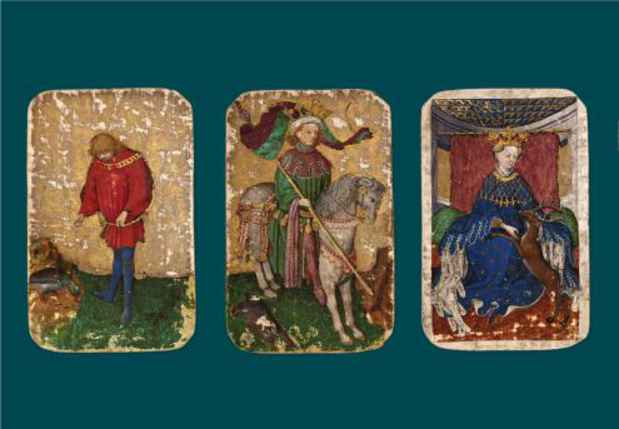“The World in Play: Luxury Cards, 1430–1540” Exhibition
The Cloisters

This event has ended.
The three hand-painted decks represented in the exhibition—the Stuttgart Cards (ca. 1430), the Ambras Courtly Hunt Cards (ca. 1440), and The Cloisters Playing Cards (ca. 1470–80)—were made over a span of some 50 years by different artists in different locations. Although each of these decks is unique, all feature images related to hunting, a favorite leisure activity of medieval nobility. The high quality of the paintings and excellent condition of the cards suggest that the luxury sets were never played. Rather, they may have served as engaging collectors’ items, like portfolios of prints or drawings, for the private enjoyment of their owners.
Representing the earliest known deck of cards is the incomplete Stuttgart Cards (12 of the 49 remaining cards in this deck are on view at The Cloisters). Although the theme is the hunt, no actual hunt is shown. Rather, the imagery of the Stuttgart Cards serves as a metaphor for the patron’s view of the world, evoking a chivalric past in which man exists in harmony with nature. The deck’s four suits are falcons, hounds, ducks, and stags.
On the basis of overall style and the treatment of landscapes, the Ambras Courtly Hunt Cards are attributed to the workshop of the noted German painter Konrad Witz. The suits are lures, falcons, herons, and hounds. Six cards from this deck are displayed.
The Cloisters Playing Cards are the earliest complete set of cards, and are among the more intriguing works of secular art in the collection of The Cloisters. The exhibition marks the first time that all 52 cards are displayed at The Cloisters at the same time. (Because works on paper are sensitive to light, normally only a small number of the cards have been shown at one time.) The suits in The Cloisters deck are nooses, collars, leashes, and hunting horns.
Six examples from the 16th-century Courtly Household cards—the earliest deck of printed cards—provide a fascinating glimpse into the organization of a late medieval princely court. The four suits correspond to the kingdoms of Germany, France, Bohemia, and Hungary. The hand-colored cards in this set are embellished in silver and gold leaf and represent the varied ranks at court: king, queen, marshal, chaplain, physician, chancellor, court mistress, barber, herald, fishmonger, and fool. Some occupations are depicted in all four suits, others appear only once. The deck represents some of the earliest German woodblock prints in existence.
A later set of woodblock printed cards from Nuremburg around 1540, by German sculptor, designer, and printmaker Peter Flötner, is distinguished by the musical notations that appear on the back of each card. The cards from this deck—all of which are shown in the exhibition—are hand colored, with silver and gold embellishments. The suit pictures—acorns, leaves, hearts, and bells—had by this time become standard in Germany.
Media
Schedule
from January 19, 2016 to April 17, 2016